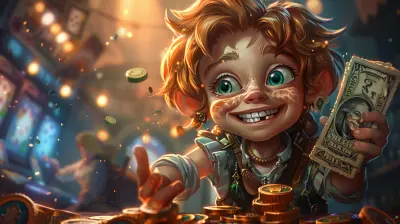How Game Developers Are Shaping the Future of E-Sports Ecosystems
14 August 2025
The world of video games has skyrocketed from a humble pastime to a global industry worth billions. And smack in the center of this digital revolution? E-sports – competitive gaming that now packs stadiums, commands millions of online viewers, and generates colossal revenue. But here’s the real MVP behind this booming industry: game developers.
Yes, you heard that right. Developers aren’t just coding characters and designing levels anymore—they're laying down the foundation for the entire e-sports ecosystem. They're the architects, the unsung heroes, turning digital playgrounds into professional battlegrounds. Let’s dive into the electrifying ways game developers are shaping the future of e-sports and why their role is more vital than ever.
The Powerhouses Behind The Screens
Picture this: you’re watching a nail-biting match between two top-tier players battling it out in a virtual arena. The thrill, the fast reflexes, the crowd roaring through their keyboards. But guess what? None of this would exist without developers shaping the playing field—literally.Game developers create more than just games—they lay the groundwork for competition. They build the mechanics, tweak the balance, and craft the experience that makes games like Valorant, League of Legends, and Dota 2 e-sports giants.
And this isn’t just about coding anymore. It’s about vision.
Creating Games Built for Competition
Back in the day, competitive play was often a happy accident. Developers made fun games, and communities turned them into e-sports titles. But today? Many developers are designing games from the ground up with e-sports in mind.They consider:
- Spectator modes to make matches engaging for viewers.
- Balanced gameplay so no character or weapon becomes too overpowered.
- Team-based mechanics to encourage synergy and tactics.
- Custom tournament tools for seamless event organization.
A great example? Riot Games. From day one, Valorant was tailored for competitive play. They integrated robust anti-cheat systems, designed unique agents with balance in mind, and created maps that reward strategy over chaos.
Fostering Competitive Communities
Let’s be real—games don’t become e-sports just because they’re fun. It takes a thriving, passionate community that wants to compete. Developers are fueling that passion like never before.They're doing things like:
- Hosting grassroots tournaments
- Offering rewards for ranked gameplay
- Engaging directly with fans and pro players
- Providing tools for content creators
These aren't optional extras anymore—they're essential ingredients. Think of developers as gardeners. They plant the seed (the game), water it (community support), prune it (game updates and balance patches), and watch it grow into a blooming e-sports scene.
Championing Accessibility
Not every aspiring pro has access to high-end PCs or gigabit internet. Developers are solving that problem, too. Through optimization and innovation, they’re making competitive gaming more accessible than ever.We’re seeing:
- Cross-platform competitive games (looking at you, Fortnite!)
- Cloud gaming options to reduce hardware dependence.
- Optimized netcode to reduce lag and give fair play to everyone.
- Free-to-play models that remove the price barrier.
This isn’t just convenience—it’s inclusion. Developers are opening the gates of e-sports to a whole new audience, and that’s game-changing.
Building Sustainable Competitive Ecosystems
Here’s where it gets really exciting: developers aren’t just thinking about now. They’re planning for the long haul. A sustainable e-sports ecosystem doesn’t rely on hype alone. It needs:- Structured leagues and tiers
- Revenue sharing
- Player support systems
- Regular updates and balance patches
Blizzard, for instance, launched the Overwatch League with city-based teams, contracts for players, and a clear seasonal structure. Riot’s League of Legends Championship Series (LCS) has become a staple, with franchising that brings stability for teams and players.
These aren’t just tournaments—they’re full-scale ecosystems designed to last.
Developer-Driven Innovation
One word: innovation. Game developers are constantly pushing the envelope, experimenting with how e-sports can be experienced and enjoyed. Think AR spectator modes, AI commentary, interactive viewing on Twitch, and integrations with the metaverse.Some games even offer in-game watch parties or rewards for tuning into live matches. It’s not just about watching; it’s about being part of something bigger.
Imagine if watching a football match let you pick plays or run alongside the players from your couch. That’s what developers are bringing to e-sports—more immersion, more participation, more WOW.
Empowering The Next Generation of E-sports Stars
We all love watching the pros, but what about the rising stars? Developers are mentoring the next wave of talent by creating structured paths from casual play to pro status.Here’s how:
- Ranked ladders linked to scouting programs
- Academy leagues and minor circuits
- In-game leaderboards that attract team scouts
- Scholarships and collegiate leagues
It’s never been easier for talented players to get noticed—and that’s no accident. Developers are building digital training grounds for future legends.
Partnering with the Broader Industry
No one builds an empire alone. Developers are teaming up with brands, tournament organizers, sponsors, and broadcasters to build a holistic e-sports world.These partnerships:
- Inject cash into prize pools and player salaries
- Create professional production quality for live events
- Attract advertisers eager to reach a global youth audience
- Expand game exposure across media platforms
Look at Epic Games’ Fortnite World Cup—millions in prizes, celebrity appearances, and global coverage. That’s what happens when devs team up with the rest of the industry.
Prioritizing Mental Health and Player Welfare
Let’s not sugarcoat it—pro gaming can be mentally draining. Developers are recognizing this and taking steps to support player wellness. From burnout to online toxicity, they’re starting to address the human side of competition.Support includes:
- Guidelines for healthy competition
- Built-in tools to moderate toxicity
- Resources for mental health awareness
- Player breaks and rest periods in leagues
By taking care of the player behind the screen, developers are creating a safer, more sustainable competitive environment.
A Look Into the Future
So, what's next?Expect more games designed purely for e-sports. More hybrid competitions mixing virtual and physical elements. More integration with VR, AR, blockchain, and AI. And yes—likely more surprise hits from developers who dare to break the mold.
The future of e-sports won’t just be fast-paced—it’ll be developer-driven, from the code to the crowds, from the interface to the international stage.
Final Thoughts: The Game Devs Are The Game Changers
Without game developers, e-sports wouldn’t just be different—it wouldn’t exist at all. They’re not just crafting games anymore. They’re creating cultures, building careers, and inspiring millions.The future of e-sports is being coded right now, one patch, one tournament, one player at a time. And behind every pixel and every play, a developer is pulling the strings, pushing boundaries, and loving every second of it.
So next time you cheer for your favorite team, remember to give a silent high-five to the folks who made it all possible.
Game on.
all images in this post were generated using AI tools
Category:
E SportsAuthor:

Madeleine McCaffrey
Discussion
rate this article
2 comments
Kieran Rios
Exciting insights! Thrilled to see how developers are transforming e-sports ecosystems ahead!
November 25, 2025 at 6:09 AM

Madeleine McCaffrey
Thank you! It's exciting to see the innovation in e-sports and how developers are paving the way for its future!
Amanda Whitley
Exciting insights! Can't wait to see the future!
August 15, 2025 at 3:39 PM

Madeleine McCaffrey
Thank you! I'm glad you found it exciting. The future of esports is indeed promising!


